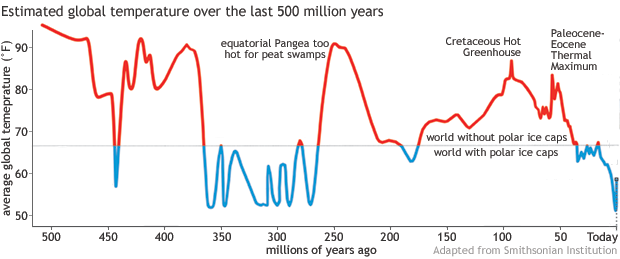A critical if sotto voce aspect of the climate debate is whether, if the weather is currently turbulent, it indicates a break with the past or more of the same. And thus, a picture being worth a thousand words and courtesy of a reader’s Facebook post, we present the following chart from that hotbed of climate lack of denialism, the U.S. governmental National Oceanic and Atmospheric Administration’s “Climate.gov”. At the very least it’s something to bear in mind when some nit says the last few years have been the “hottest ever”. Or that climate was stable until 1970.

If you’re thinking the last bit might make for a splendid little hockey stick, whatever the heck the rest of it means, please note that the scale is in millions of years and you’re looking not at the late 20th century but at the rebound from the depths of the Pleistocene. Or someone editorializing with the data set. And if anyone tells you that if it gets another degree warmer the cute plants and animals get it, please laugh. In fact in the PETM, the Paleocene-Eocene Thermal Maximum, most of the things you want to pet began to evolve. Including humans, if we’re on your nice rather than naughty list.
Some people might “go Greta” on us, to borrow a phrase from a viewer, and say well look, when equatorial Pangea was too hot for peat swamps it might have been kind of nasty. I mean what would flourish under those circumstances? Other than, say, dinosaurs, who first appear in the fossil record around 240 mya and began their meteoric rise to glory (oh, sorry, don’t mention meteors near dinosaurs) after the Triassic-Jurassic extinction event roughly 201.3 mya.
“Aha, extinction!” some may rebel. Yes, after a long cooling stretch, and not because of the temperature anyway as far as anyone can tell. Although to the modern person with a hammer, there’s a powerful urge to speculate about climate change and probably CO2. To everyone else, you’ll note that the “Cretaceous Hot Greenhouse” sees, well, flowering plants appear. And those incredibly cool horned dinosaurs that flourished symbiotically with them. And T. Rex to pose in those famous showdown pictures with a Triceratops. At least they were famous when we were kids and dinosaurs were clumsy green lizards.
Perhaps that last observation is beside the point. Which is that if you’re following the science instead of the polemics, you’ll notice an odd feature of this chart: It suggests that the current ice age, defined as a period with significant polar ice, has been going on not for the conventional 2.5 million years, when the Pliocene became the Pleistocene, but for more than 30 million, except that tiny little red cap there about 20 mya with a pompom or something just before it, as geologists use the term “just”.
That’s one odd feature. Another is that you’d also conclude that there’s an ominous long-term cooling trend going on which has mass extinction written all over it. And then you’d Google “Eocene fauna” to try to figure out what happens if, by natural or unnatural means, we somehow did push things back up into typical Oligocene conditions (because on Googling you’d find that the Eocene was from about 56 to 33.9 mya and then came the Oligocene until about 23 mya). Would it turn the planet into Al Gore’s semi-famous “Nature hike through the Book of Revelation”, which is how he described the supposedly extreme weather conditions prevailing 15 years ago, which awkwardly is before climate change really hit us according to more up-to-date alarmists? Or would life prosper?
So you’d Google “Oligocene fauna”, because these online searches are like potato chips. And you’d learn that “Carnivores such as dogs, nimravids (ancestor of cats), bears, weasels, and raccoons began to replace the creodonts”. Nimravids, no less. Alas, the Brontotheres bite the Oligocene dust because it is getting cooler which apparently isn’t good for charismatic megafauna. As Wikipedia says “There was significant diversification of mammals in Eurasia, including the giant indricotheres, that grew up to 6 meters (20 ft) at the shoulder and weighed up to 20 tons. Paraceratherium was one of largest land mammals ever to walk the Earth. However, the indricotheres were an exception to a general tendency for Oligocene mammals to be much smaller than their Eocene counterparts.”
Well, we could go on and on and arguably already did. But the point here is that if you actually study the past history of the Earth’s climate, even inside an outfit like NOAA, what you discover is that climate is highly variable, and normally it’s much warmer than it is today, and that cold conditions are not favourable to life. None of which is to say an immediate 10° temperature increase would not be catastrophic for humans and a great many other species. But it is to say that we need to put terms like “unprecedented” and “hottest ever” into perspective.
Specifically the perspective that, as used today to mean “things that actually happened a lot just not in the last five years that we noticed.” Usage which deserves to go extinct, meteor or no meteor.



We have lived in and around the lower Vancouver Island area for 50+ years. The hardiness zone has not changed one bit in all that time. You can equate the hardiness zone with climate, although it only refers to winter temperatures, if the world was warming the hardiness number of our zone would be increasing but it is not. We have had the same sort of weather over that entire 50 years, since climate is apparently defined as weather over thirty years the climate around here at least has been stable in the short term. I sincerely doubt that much will change in the next 30 years. I derive much amusement from the prognostications of the computer operators who ignore the actual observations and prefer their "data".
Why do you not show temperatures in degrees Celsius? Fahrenheit is an outmoded temperature scale... for tyhe rest of the world.
What's the difference -- the shape of the chart would be exactly the same?
We didn't create the chart, we just reprinted it, from an American source. Hence the Fahrenheit scale.